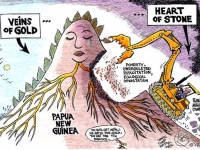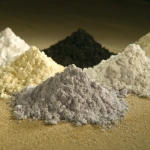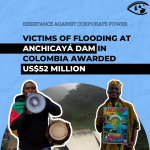Barrick Gold Mine Transforms Pacific Island

Listen to interview with Author, David Martinez.
The giant yellow trucks lumbered on six-foot high tires to the cliff's edge. The driver, in a cabin high above the ground, raised the 200-ton beds and released a massive slide of rock and mud debris hauled from the Porgera gold mine. Big muddy bulldozers, the size of a small house, emerged from the evening cloud cover to push more dirt into the valley below.
And so it goes all day every day in the highlands of Papua New Guinea. After 14 years, the mine waste has slowly torn the hills from under the local inhabitants and turned the small valley below, an extension of the Porgera Valley, into a choked river of dirt creeping toward the Gulf of Papua two hundred miles away.
The destruction is fueled by gold. Mining for gold is one of the world's most grotesque industries, consuming vast resources and producing mountains of waste to produce a small amount of soft, pliable metal with few practical uses. To make one gold wedding band, at least 20 tons of earth must be excavated.
The Last Great Place
Papua New Guinea, one of the world's largest island, has fortunes in gold under its lush green mountains. Called the "Last Great Place," it is home to hundreds of unique species of animals and plants from tree kangaroos to orchids of unearthly beauty, as well as to upward of 820 languages. It is the closest thing you may ever see to paradise: forested mountains surrounded by shining South Pacific seas, where clean water springs from rich volcanic soil. And that makes the poverty of its inhabitants and the destruction of its ecology all the more heartbreaking.
The Porgera valley is a microcosm of the kind of poorly regulated exploitation that marks extractive industries around the globe. The 5,600 acre open-pit complex called the Porgera gold mine is in Enga, the highest and most rugged province in Papua. It produces around 635,000 ounces of gold per year, according to Barrick Gold, a Canadian corporation that assumed a majority share of the mine in 2006. Barrick is no stranger to mining or to controversy: It operates no fewer than 26 mines worldwide, posted a profit of $1 billion in the first nine months of 2006, and boasts of having the industry's largest reserves.
In addition to Porgera, Barrick runs the Pasqua Lama mine in Alto de Carmen, Chile, currently the target of a campaign that shut down the road to the mine for a week in January of 2006.
These mines are part of what the United Nations Industrial Development Organizations calls a "gold rush in the Third World" that began in the 1980s. With demand 50 percent higher worldwide than supply, the industry is likely to be profitable for years to come. As Papua New Guinea's biggest gold mine, Porgera is part of an extractive industries megalith that includes oil and copper, and accounts for 72 percent of the country's export earnings.
The mine at Porgera is far from the famous Sebastian Salgado images of thousands of Brazilian workers slaving away by hand in a giant mud pit. It is a state-of-the-art, high-end operation utilizing the most advanced extraction technologies and helicoptering people and gold in and out on a daily basis. But like its low-tech counterparts, its extraction process creates cyanide-laced waste-water that the company discharges directly into the local river system. Only one microgram (one millionth of a gram) of cyanide in a liter of water can kill the fish. Because Porgera is literally at the top of the country, the streams into which the toxins are dumped flow into many other tributaries before they reach the sea.
The mines have also affected Porgera's human ecology, propelling the local population out of the stone age in a single generation. The Ipili had the misfortune of living on top of a lot of gold. Known for their fighting abilities (every male over 12 carries a hand-axe or a machete-like bush knife), they were also proud of their shrewd bargaining skills. Thus, when Placer Dome (later taken over by Barrick Gold), one of the biggest Canadian mining companies, came to the region proposing to open a mine, the Ipili went to the negotiating table with gusto.
Anthropologist Alex Golub lived for three years in Porgera while writing a dissertation on the relations between the Ipili and the mine. He told the story this way: "They told Placer: 'We want a high school, we want a hospital, we want long-term economic development, we want a road, we want an airstrip, and we want a town to be built. If you agree to this, you will have your mine. If you open a mine without our permission, we will kill you.' "
The agreement that was reached between the locals and the company was hailed as a landmark deal because up to that point landowners had seldom if ever been involved in negotiations at all. Porgera Joint Venture (PJV) company, the entity that Placer Dome created to run the mine, would pay the Porgerans for the use of their land, pay dividends to the families of the original landowners based upon how much gold was mined, and build a school and other buildings for the town.
According to an article in the Ottawa Citizen, the company also handed out large amounts of money. In 2006 the landowners received more than $8 million in compensation, and to date more than $30 million has been spent on development projects in Porgera, on top of $380 million in taxes and royalties to the Papua New Guinea government.
"[T]he Porgera operation really works when it comes to providing benefits to local people," PJV general manager Phil Stephenson told the Papua New Guinea Post-Courier. "It is constructive partnerships such as this that go a long way towards continuing to build both the national economy and local infrastructure, and I know that workers at the mine feel very proud to be involved when they hear of such benefits."
But it didn't last forever. Things ran relatively well until the early 1990s when the most accessible veins of ore were depleted. It was then that the company turned to open pit mining, began blasting away the hills, used cyanide and other toxins to leach gold from the rubble, and dumped the poison waste into the local streams.
Although PJV paid villagers to relocate to new houses in the hills above the despoiled valley, over the years, the homes started sinking into the ground or sliding slowly down the hill as mine debris eroded the landscape. As time passed, the villagers began to measure the deal and their cheap tin houses against the despoiled environment and the wealth the mining company has extracted.
"We don't want the mine to shut down," says Willie Gaupe, an organizer who is working on behalf of the people who own the land in and around the valley. "We want to be fairly compensated. We did not expect that the houses they built would begin to fall off the hill as they are. "
Increasingly the villagers grew to rely on the mines for sustenance, whether through wages or lease payments. Many of them are now "reeling from the impact of a cash-for-land deal that has turned their traditions upside-down and their ancestral home into an industrial moonscape patrolled by guards and police, including one of Papua's notorious 'mobile units,' renowned for savage human-rights abuses." according to the Ottawa Citizen article.
Between 8 and 39 people have been killed in fights between company security men and alluvial miners, depending upon whether it is the company or the locals making the count. Many people pan for gold in and around the mine, and as the mine itself has grown bigger and bigger, and the local population exploded and clashes have erupted over access to the precious yellow ore. When would-be gold panners get near company property, guards fire at them, claims Akali Tange Association (ATA), an organization that advocates against human rights abuses in the area. The mine claims that locals attack the guards with clubs and rocks and are trespassing in the first place.
ATA counters that no Ipili ever said they would give up their traditional right to engage in alluvial mining, regardless of any agreement with the company. The end result is that the company hired a 400-man security team, which it calls Asset Protection Department, to guard the facility. Over the years, what started as a congenial arrangement has turned into small-scale armed conflict that has caused hundreds of injuries, sometimes 40-50 a day.
The company responded to accusations that their employees were merely trying to remove the alluvial miners for their own good. "The issue is one of safety. Illegal miners were not trained, dressed or equipped to operate safely in the environment of the mine, where there were loose rocks, heavy equipment and blasting taking place," a PJV spokesman said in an interview with the Papua New Guinea Post Courier.
"Any legitimate enquiry would reveal that PJV used the utmost restraint in dealing with a difficult crowd control problem, and that its own security, safety, community affairs and rescue personnel were placed at grave risk every day by the intrusions. An enquiry would help to explain to the public and to the relevant authorities that gold thieves were creating a dangerous safety situation, which PJV was obliged to deal with."
Growing inequity and changing social structures exacerbated dissatisfaction between the mining company and the locals. New arrivals seeking work at the mine, who currently account for 40 percent of the 10,000 people living around Porgera, and relatives of landowning families began demanding a share of the monetary compensation. This phenomenon is perfectly normal among Papua New Guineans who share any fortune, good or bad, with their tribe and extended family. Even in the capital city of Port Moresby, far from Porgera, groups of more than 100 people sometimes gather in open fields to settle disputes. Typically a group of approved elders makes a judgement awarding cash to the injured parties, who divides it among their relatives. It is customary, for instance, for a man who is gravely injured in a brawl to receive a large sum in compensation from the attacker's clan, which after being divvied up amounts to only five dollars or so for each relation.
Fighting among tribes and families is also common, which is sometimes expressed by burning down public buildings. This was the fate of the school that the PJV built at the locals' bequest and which now sits charred and empty.
Workers Organize
Stanley Kaka, a 44 year old former mineworker and union organizer, embodies a living history of the Porgera region. As a child in the 1970s, he and the other village males slept in a longhouse with hammock-bunks lining the walls. Nearby was a similar building for the women and children. "We would stay up late every night," he recounts, "telling stories, talking... you know. In the morning we all rejoined our families and went to work in the gardens." Everyone wore grass loincloths and hunted with bows and spears.
Kaka is now a smiling, cell-phone wielding man wearing slacks and a button-down shirt. "From Stone Age to Computer Age in one generation," he sighs. "No wonder people are still catching up."
In 1989 Kaka moved to Porgera from a nearby village and started working at the mine. He immediately noticed how unfairly the employees were treated. People worked long hours for low wages and were exposed to toxic chemicals, he says. He and other workers formed the Porgera Allied Workers' Union with Kaka as its first president. The union won overtime pay, travel compensation for miners who came from distant townships, and special risk pay for the men who worked in the dangerous tunnels deep under Porgera's hills.
It was during one of the union's actions, a "sitting protest" inside of a tunnel, that the company security men clashed with the miners and angry workers destroyed a digging machine. Mine officials blamed Kaka for starting the trouble and fired him.
"I told the company that I will be here until you leave this place. This is my land," he said. For the last 16 years he has been "not leading, but advising" the young generation, the young people who are coming up and saying this is no good. We should at least get maximum benefit out of our resources that company's taking out."
The lack of benefit is evident in Porgera, a town with one of the world's largest gold mines and no paved streets. As helicopters ferry wealth overhead, crews of mud-covered young men with picks and orange plastic vests wedge rocks and gravel into deteriorating dirt roads to counter erosion from frequent rains. The overall sense is of an outside corporation extracting what it can at minimum cost, ready to pack up and clear out when the gold supply runs dry.
Which is not to portray the Porgera Ipili as helpless victims. As Alex Golub explains that the dramatic closing of the Bougainville copper mine (on an island off the main island of Papua) by the Bougainville Revolutionary Army in 1989 created a moment of opportunity: "which the Ipili," who are nothing if not ready to negotiate - seized and became one of the most active and successful Fourth World (indigenous) people in the world today in terms of pressing claims against the state and transnational capitalism."
Adds Golub: "Indeed, so thorough-going are Ipili attempts to extract benefits from the mine that Timothy Andambo, a Porgeran mining engineer, has described the tangle of trust funds, equity companies, and committees that manage the Ipili's numerous investments as social technology to extract rent from the Porgera lode."
In his writings Golub insists on a complex reading of the situation, an understanding of the "shades of grey" that exist vis-a-vis mining companies in Papua New Guinea. Indeed, for all the problems surrounding the mine at Porgera, Alex points out that its reputation is dwarfed by the infamous Ok Tedi mine in nearby Western Province "which has dumped enormous amounts of cyanide into a into the river that runs through the largest rainforest in the world outside of the Amazon."
Mining Aftermath
The only thing worse than having a mine, is the aftermath when it shuts down, if the nearby island of Misima is a model. The Solomon Sea stretches away to the north of Misima and the mighty Coral Sea rolls in from the south, which makes Misima feel like a small raft of jungle floating in the middle of a vast, choppy ocean. Women sell dried fish under stalls near the harbor and a few yachts over on vacation from Australia lazily bob in the harbor. Compared to the bustle of Porgera, Misima is slow island life.
A few years earlier, the Misima Gold Mine, another massive open-pit operation, shut down after 11 years of operation. It had been run by Placer Dome, the same company that operated the Porgera mine before being acquired by Barrick Gold. Its legacy includes a landing dock that is now huge corroded iron frames filled with boulders that jut out of the banging surf. Mysterious machines sit rusting in the forest like dead giants. The vanishing company left a changed society, an empty economy, and a huge hole in the forest filled with water where the mine was. Placer Dome turned the site into a reservoir and promised to build a turbine that would use the water in the pit to generate electricity. Then it closed up shop and left, having extracted 37 million ounces of gold and 18 million ounces of silver.
"Before the mine," said Joseph Polisbo a middle-aged man in neat work khakis, "life here was based on subsistence farming, and people didn't rely on a cash economy. It was like a culture shock to the people here, and life changed dramatically. There were new opportunities, and life changed and improved for a lot of people."
But after the mine left, it proved hard for the Misimans to return to life without wage labor. The landowners who had been receiving royalties were suddenly without incomes, the community lacked infrastructure.
Polisbo motioned upwards in the warm air toward a row of cables running alongside the road. "We are right under the power lines now which were once serviced by the mine itself, which is no longer in existence, and so now they sort of just decorate the place."
He looks with hope to the nearby island of Bougainville where people "have done well and it is not only because of the mine, it is because of the agriculture, the coco they raise, and whatnot. So I began to realize that mining is not the only solution. And I think we can do it here ourselves, with the seas we have here. If Bougainville can do it then Misima can too, and so can all of Papua New Guinea."
The Porgera Mine War
That remains to be seen. Set in the brilliant South Pacific, Papua New Guinea is rich: rich in resources, in ecology, in languages and cultures - and yet the people are poor. The country's wealth is being removed by helicopter and pipeline, with the benefits funneled out of he country, the lion's share going to foreign companies. It is cheaper for citizens to fly to Australia, its huge neighbor to the south where most of the companies are based, than to fly within their own country. (The lack of roads in the world's second largest rainforest after the Amazon often makes air travel the only option.)
Back in the chilly mountains of Porgera, local ATA organizers are now working on ways to hold Barrick accountable for a series of incidents in which mine security forces had injured workers. One milestone will be a ruling expected soon from the sluggish, woefully corrupt Papua New Guinea courts.
The company, meanwhile, is trying to negotiate a settlement. PJV's Stephenson told the Papua New Guinea Post-Courier : "We have reached a stage where we ourselves are also not prepared to accept any more deaths. All our lives are affected when someone in the community is hurt or killed. We need to work together to find solutions."
The men of ATA, however, remain skeptical. "But," said one man, motioning forcefully with his arms, "if nothing is resolved, we will shut down this mine in less than a day. We can do it anytime we want to and we will." The Ipili of Porgera know what has happened in Misisma and they say they are determined to make sure they are not left with just dirt roads and despoiled hills when the gold finally runs out.
This article was made possible by a generous grant from the Hurd Foundation
- 104 Globalization
- 110 Trade Justice
- 116 Human Rights
- 183 Environment



